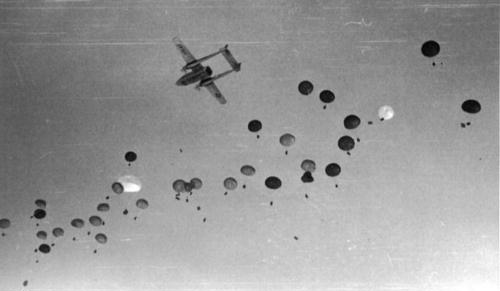|
CHANGJIN JOURNAL 12.15.02
IN THIS ISSUE we look back
from our fifty‐second anniversary of the Chosin breakout at the 57th Field
Artillery Battalion that was attached to the 31stRegimental Combat Team (RCT 31) east of
the Changjin Reservoir. We are reminded that Charlie Battery had been detached prior to
the move to Chosin, although A Battery of the 31st FA Battalion (155mm) had been
attached; the battery did not arrive before the Chinese cut the MSR on 27 November 1950.
The basis for this presentation is a letter from Colonel
Edward L. Magill, JAGC, USAR (Ret) to Roy E. Appleman, written shortly after reading
Appleman's book Escaping the Trap. This was also the basis for
"Ted" Magill's presentation of the artillery story at a Chosin Few
reunion that resulted in a favorable change in the attitude of many Marines about the
performance of Army units at Chosin.
57th FIELD ARTILLERY BATTALION
After occupying a
non‐tactical position in the late afternoon, Baker Battery settled down for the
night. Lt. Morrison fired registration rounds but there was no other firing. During the
early evening, a few Korean refugees passed through our position and indicated that they
had seen a large number of soldiers to the north. Nobody took them seriously. The
evening of 27/28 was not too bad from our standpoint. We did not know that Item, Love
and King Companies and Able Battery were under attack until well after midnight. The
first thing that alerted us was the sound of bugles. Oddly enough, we did not hear much
small arms or mortar fire from their positions farther north in the inlet until early in
the morning. We received some small arms fire in our position but not a great deal.
Initially, the Chinese attacked Item, Love, King Companies, and Able Battery north of us
and Headquarters Battery to our south, but bypassed Baker Battery for awhile. At dawn,
men from Love, King, Item Companies and Able Battery filtered back into our position.
When daylight arrived, we could see that the Chinese had pulled out of the Able Battery
position and had not removed or damaged its guns. We then moved farther north and went
into position in the inlet next to Able Battery. After the move, all of the 3rd
Battalion and its supporting units were within the inlet perimeter. Generally speaking,
the Able Battery guns were emplaced on the east side of the perimeter, aimed in a
northerly direction, and the Baker Battery guns were located on the west side of the
perimeter, aimed in a southerly direction. Each battery was responsible for covering
half of the perimeter. Baker Battery's westernmost gun was very close to the
railroad track. It was probably not more than 50 feet from Sgt. Branford R. Brown's
M‐l9. (See map 9, page 117.) The guns were not well dug in because of the frozen
condition of the ground.
During the nights of 27/28
and 28/29, I was primarily concerned with the local defense of the battery. The same
situation was true for Lts. Eichorn, Tackus and Smithey. Unfortunately, on the night of
28/29, Baker Battery suffered extremely heavy casualties. Lts. Morrison and Stysinger
were both killed. Lt. Anderson was seriously wounded. All the rest sustained minor
wounds and were beginning to have frostbite problems. But they all could function. We
lost four chiefs of section and numerous cannoneers. Sgt. Nitze, a chief of section, was
decapitated when a mortar round landed on his helmet. Gun crews were firing almost all
night long. Of necessity, firing battery personnel were standing on top of the ground,
servicing their guns. Consequently, they sustained heavy casualties from mortar fire.
Mortar shells exploded almost at the instant of impact because of the frozen ground. The
explosions caused maximum fragmentation and concussion effect.
During the battle at the
inlet, Baker Battery did not operate under battalion control. Almost all of our
artillery fire was direct. We were covering the ridgelines and the avenues of ingress
into the southern half of the perimeter. At times, our gun tubes were depressed as far
as possible and fired so that the shells would ricochet off the frozen ground and obtain
maximum fragmentation effect against the advancing Chinese infantry. Fuses were set at
minimum arming range. During the early morning of November 29, I became the "de
facto" battery commander. By that time, we were already very short of food, water,
artillery shells, small arms ammunition and manpower. There was very little medical
assistance available for the wounded, many of whom simply froze to death. We had
received some air resupply, but it was spotty at best and a substantial part of the air
drop supplies fell into areas controlled by the Chinese.
I was quite surprised when the 1st Battalion, 32nd Infantry Regiment, arrived
at the inlet on the morning of November 29. Nobody had mentioned to me that there was
another infantry battalion in the area. The arrival of this unit was very heartening as
we certainly needed the additional troop strength. On page 114, you mentioned that
nobody from the 57th Field Artillery saw Col. Alan D. MacLean as he traveled across the
ice next to the bridge approaching the perimeter. Actually, Sgts. Copelan, Brown and I
all saw him coming across the ice. We were standing next to Sgt Brown's M‐l9
when we saw him come out onto the ice and move toward the perimeter. He was a large man
and we had a clear line of sight. At the time, we did not know who he was and did not
learn his identity until later. He was hit several times and staggered, fell and finally
was led off the ice by what appeared to be Chinese soldiers. Some friendly troops on the
south side of the bridge were trying to assist Col. MacLean but were unable to reach him
in time. While this was going on, vehicles from the 1st Battalion were erratically
crossing the inlet bridge at high speed.
At the time
Col. MacLean was crossing the ice toward the perimeter, Baker Battery and the
M‐16s and M‐19s of D Battery, 15th AAA, were heavily engaged trying to
contain a Chinese attack from the south. Consequently, these units were not able to
direct their attention toward the inlet bridge approach to the perimeter.
In my opinion, there are two men who have never received
proper credit for their contribution to the inlet defense. They are Sgts. Brown, D
Battery, 15th AAA Battalion, and Edgar Copelan. Sgt. Brown commanded an M‐l9 and
was especially skilled in directing the fire of its twin (dual) 40s. He was a very
courageous and capable NC0 who performed exceptionally well during the entire battle.
The most impressive thing about him was his calmness and good humor under the most
trying of circumstances. Sgt. Copelan was Baker Battery's chief of firing battery.
He had combat experience in Europe during
World War II. He was also an
outstanding NC0 who was thoroughly proficient in the use of the 105s. He played a key
role in keeping Baker Battery's guns manned and firing. Like Sgt. Brown, Sgt.
Copelan was very calm and good‐humored throughout the ordeal. These two men
performed magnificently and provided great inspiration for their soldiers. And, they
certainly were of immense help to me in operating the firing battery.
The night of 29/30 was not as bad as the previous night. By then, the
perimeter defense had been reorganized to incorporate the units of the 1st Battalion,
32nd Infantry, which strengthened the perimeter defense. However, the
ever‐increasing number of casualties was becoming a critical problem. The men
were very concerned about being hit because they knew there was a good chance that they
would freeze to death if they were immobilized. The remaining medical personnel were
close to exhaustion and there were few medical supplies. There was no satisfactory cover
for the wounded who were unable to ambulate. Truck tarpaulins and supply parachutes were
used to cover the wounded wherever possible. I kept telling Lt. Anderson that he would
probably be evacuated by helicopter although I knew that was unlikely. He was well aware
of the situation even though he was critically wounded. Supplies of food, water and
ammunition were being rapidly depleted. Remarkably, the troops remained in pretty good
spirits, everything considered. What they lacked in unit training and experience, they
more than made up for in courage and determination. By November 30 Baker Battery was
down to five, later four, guns.
The two helicopter medical evacuation flights
that removed a small number of wounded from the inlet on November 29, provided some
temporary encouragement to the wounded men. They began telling themselves that other
helicopters would come in later and evacuate the most seriously wounded. That, of
course, was not to be.
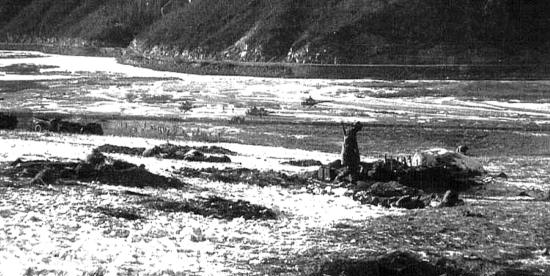
The Inlet perimeter. In center of picture
are three helicopters that landed to pick up wounded, landed about 400 yards SW of
the bridge. In center foreground is mortar position of L Company, 3/31. Man in photo
by the hole is squad leader Sgt. Luther Crump.‐‐ Photo
courtesy William Donovan, L3/31/7.
When Maj. Gen. David G. Barr flew into the
position on Nov. 30, his helicopter landed a short distance east of Sgt.
Brown's M‐l9. He was met by a couple of officers who took him to find
Lt. Col. Don Faith. After his meeting with Col. Faith, he returned to his helicopter
and immediately left the inlet. He did not spend any time trying to encourage the
troops. In retrospect, Gen. Barr must have decided that the battle was about over
for the perimeter defenders and that there was little chance of any of them
surviving the engagement. That's the only logical conclusion one can reach as
to why the 31st Infantry Rear and 31st Tank Company were ordered to withdraw from
Hudong‐ni to Hagaru‐ri on the afternoon of Nov. 30. Gen. Barr had to
realize that withdrawing those units eliminated any chance the troops at the inlet
had of completing the trek to Hagaru‐ri as an effective fighting force. Had
the tank company and supporting troops remained, the inlet force would have had a
much better chance of remaining substantially intact, including the truck column,
and successfully making its way to Hagaru‐ri. [Note: At the time Gen. Barr
visited the Inlet units he was not in command of those units, for on the previous
night all Army units in the Chosin area had been attached to the 1st Marine
Division. ‐ Editor]
The fighting was fierce all through the
night of 30/1. Baker Battery had a direct field telephone line to the infantry units on
the south side of the perimeter that was being manned by Lt. Keith E. Sickafoose, 57th
Field Artillery, who was directing the fire. I can still hear him saying, "Oh
s‐‐‐! They've broken through again." (Lt. Sickafoose was
a USMA graduate, Class of '49.) We were firing direct at minimum arming range. We
used up most of our remaining HE shells with point detonating fuses. By daylight the
Chinese had fought their way into the Baker Battery gun position. A group of Chinese
infantrymen infiltrated the position by moving along the railroad track from the south
and were lobbing hand grenades over the embankment. They were killed near the 105s. One
Chinese soldier came running toward me s I stood next to a 105. Some of the cannoneers
were yelling at me to shoot him but he was wearing a GI field jacket and I thought he
was an American. He jumped on me, wrapped his legs around my waist and started hitting
me on the helmet with a "potato masher" hand grenade. Fortunately the grenade
didn't go off and I killed him with a carbine bayonet that was tucked in my boot.
The cannoneers thought it was pretty funny. When daylight came, Baker Battery was in
very tough shape. We had almost no ammunition left and only four guns that would shoot.
I had three hand grenades, and 22 rounds of carbine ammunition, a carbine bayonet and a
carbine that wouldn't fire. Fortunately, the Chinese withdrew shortly after
daylight rather than follow up with one more determined infantry attack which probably
would have succeeded in overrunning the position.
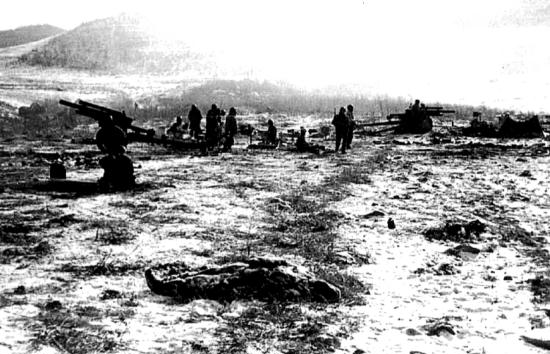
Two 105mm with crews, pointed left and right.
Haze in the air may indicate early morning fog and firing of the guns. Low barrel
position of gun on right indicates it had been firing "direct fire" at
attacking Chinese. ‐‐ Photo courtesy Ivan Long, Hq/31/7
BREAKOUT
The sky was overcast and
there was no air cover. We tried to police up the position, distribute what little
ammunition was left and prepare for the next attack. A section chief, Sgt. Hodge, gave
me part of a half of a frozen peach. That was all the food he had left. While we were
discussing our predicament, an opening appeared in the overcast and a couple of Corsairs
came through providing us with some much‐needed air cover.
During mid‐morning, word filtered down that we were going to try
to break out of the perimeter and proceed to Hagaru‐ri. Subsequently, we unloaded
all of the trucks that would run. The only items left on the trucks were tarpaulins.
Whatever gasoline was available was put into the trucks. When the unloading job was
completed, there were 23 trucks ready to be loaded with wounded. Throughout the morning
we received sporadic mortar fire and automatic weapons fire causing numerous additional
casualties. I was hit in the legs by mortar fragments. The same round killed two of my
NCOs.
We decided to put Sgt. Brown's
M‐l9 at the head of the column. He had no 40mm ammunition left but we thought
that the tracked vehicle would be more effective in breaking through obstacles than
wheeled vehicles. All remaining artillery ammunition was expended and the guns were then
destroyed. Most of the available trucks belonged to the 57th Field Artillery and were
being driven by its men. Only the wounded who were unable to walk were loaded on the
trucks. We did not move out of the perimeter, however, until we received a specific
order from Maj. Gen. Oliver P. Smith over Capt. Ed Stamford's TAC radio. I was
standing next to the radio when the message came through. That order was received about
1 p.m.
After receiving Gen.
Smith's order the column moved out and quickly ran into a Chinese roadblock
constructed of logs placed across the road, covered by automatic weapons and small arms
fire. At the time four Corsairs were covering the inlet. Capt. Stamford instructed the
Corsairs to come down and knock out the roadblock which we marked for them. The first
Corsair came down the column, north to south, at tree‐top level. The pilot
dropped a napalm bomb which landed right on top of Sgt. Brown's M‐19.
Several members of the M‐19 crew, who were aflame, came off the mount screaming.
Some of the
napalm sprayed off of the M‐l9 to the left of the
road and hit some other soldiers. One of the M‐l9 crew members came directly
toward me, aflame. My first reaction was to shoot him (which I couldn't have done
as my carbine wouldn't fire). We threw him to the ground and tried to smother the
flames. We were able to put the flames out but he was mortally wounded. We then put him
on one of the trucks. In the meantime, the remaining Corsairs had neutralized the
roadblock. The M‐l9 was still running and Sgt. Brown somehow got it moving. The
napalm incident startled everyone. The troops in the immediate area became disorganized.
After some delay, the column started moving again.
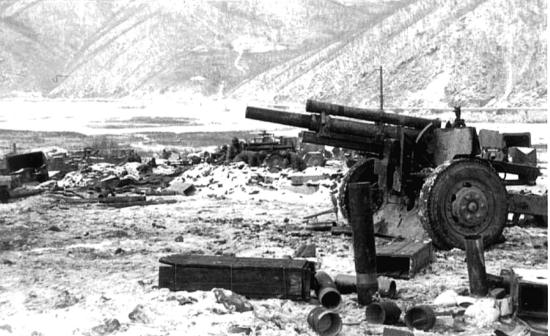 The absence of men around this gun indicates the photo may have
been taken on 30 November, the day before the breakout. By that time casualties reduced
the crews available, and the shortage of ammunition reduced the need for manned
guns.‐‐ Photo courtesy Ivan Long, Hq/31/7
The absence of men around this gun indicates the photo may have
been taken on 30 November, the day before the breakout. By that time casualties reduced
the crews available, and the shortage of ammunition reduced the need for manned
guns.‐‐ Photo courtesy Ivan Long, Hq/31/7
Shortly before the truck column moved out, I
met Col. Faith for the first time. He was wearing ODs, a sheepskin vest, and was holding
a .45 automatic in his right hand. He ordered me to organize any available unassigned
troops for flank protection on the forward, left‐hand side of the column, which I
did. The column moved south until it came to the first bridge that had been destroyed
(map 11, p. 149). During that part of the trip, the column received small arms and
automatic weapons fire from the high ground on the left, the marshes on the right and
the road in front. We had some air cover. All of the aircraft were Corsairs (F4Us). The
only F7F that appeared over the area was at Hill 1221 much later in the day. It should
be emphasized that by this time there was no effective means of communication left. The
troops from various units had become so commingled that there was no unit integrity.
Consequently, there was no functioning chain of command and the column was moving of its
own volition.
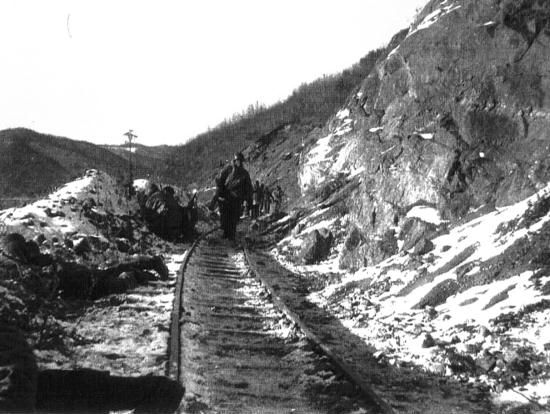
This photo is on the way out. The men are from Company M,
3/31, and are part of the rear guard.
This was several miles south of the Inlet. The two men lying
in the foreground are dead. The road is just over the bank to the left, and the
trucks, at the time I took this photo, are about 100 yards behind me. A Chinese
foot column is less than 100 yards to the rear of the men pulling out.
Heavy enemy fire is coming from the hill, visible in the rear.
I estimate this photo was taken about 1530 hours." ‐Photo and
text courtesy William Donovan, L3/31
When the lead vehicles reached the
first knocked‐out bridge, and one of the trucks broke through the ice trying to
bypass the bridge, the column came to a halt. The troops on the left‐hand side of
the column fanned out toward several buildings in the valley. They got mixed in with
other soldiers. At that point, we were receiving heavy small arms and automatic weapons
fire both from the north side (Hill 1456) and the south side (Hill 1221) of the
streambed. We were taking heavy casualties. At this point, Lt. Tackus was critically
wounded. He was shot in the back of the neck by a small‐caliber bullet. While
trying to help him, I could see the bullet lodged near his cervical spine below the base
of his skull. He couldn't move.
HILL 1221
I knew that something had to
be done to neutralize the machine gun fire that was sweeping the road and bridge from
the crest of Hill 1221. About this time, a fairly large body of troops, about a
company‐sized unit, moved across the valley floor, in a southerly direction, and
disappeared from sight to the east of Hill 1221. Somebody said that it was A Company of
the 32nd Infantry. I moved up to the road on the side of Hill 1221. There were quite a
few soldiers huddled in a ditch between the road and the base of the hill. I tried to
cajole them, encourage them or do anything possible to get them going so we could attack
the Chinese on top of the hill. But most of them apparently had gone as far as they
could go. An infantry officer laying on the bottom of the hill was also trying to rally
the soldiers. He was badly wounded, but he urged the troops to move out even though he
was unable to get to his feet. At any rate, I did get a few volunteers, perhaps a squad,
and organized them for an assault on the hill. One of the men in the group was from
Capt. Stamford's TACP. He had lost his trigger finger mittens so I gave him my
scarf to wrap around his hands so they wouldn't freeze. He was killed later in the
day.
Frankly, I wasn't sure
that I'd ever make it to the top of the hill. I had not slept and had had almost
nothing to eat or drink since Nov. 29. Halfway up the hill, I discarded my field
overcoat because it was too heavy and restricting. After that, I was wearing a pile
liner as an outer garment. Every step forward was a struggle. A Chinese machine gunner
on top of the hill fired at me the entire time I was making my way up the hill. He
nicked me several times but I finally got close enough to finish him off with two hand
grenades. I had lost most of my makeshift squad on the way up the hill. My carbine was
still wouldn't fire. It was very late in the afternoon when we reached the top of
Hill 1221. Lt Eichorn led another small group of soldiers up to the top from the
northwest side of the hill. As soon as we entered the Chinese trenches, an air strike
came in and plastered us. We were worked over with rockets, machine gun fire and napalm.
There was one Grumman F7F in the group of four attacking aircraft. That was the only F7F
I saw that day. The air strike finished off most of the remaining soldiers.
Following the air strike there were no live Chinese left in
the immediate area of the crest of Hill 1221, which temporarily eliminated a problem for
the truck column. There was still enough daylight to see. I scanned the area through my
field glasses from this vantage point. Looking back toward the knocked‐out
bridge, I saw a company of what appeared to be North Korean soldiers traveling west,
parallel to the stream bed, along the base of Hill 1456. I thought that they were North
Koreans as they were dressed in grayish‐white uniforms. The top part of their
uniforms included fur‐lined hoods. Their uniforms were not the same as the olive
drab quilted uniforms the Chinese were wearing. They also looked larger than Chinese.
This group came up behind the truck column, moved along both sides of the trucks, poured
gasoline on the wounded men and set fire to them. It was not a very pleasant sight to
see. By then, a few of the trucks had bypassed the knocked‐out bridge and were
stopped along the road on the north side of Hill 1221. The truck column was no longer
being effectively defended as far as I could determine. It was obvious that the trucks
were not going to make it much farther. I could not observe any military activity taking
place to the east, west or south of Hill 1221. My view in those directions was blocked
to some extent by wooded areas and intermediate masks. Darkness fell.
After reviewing the situation for a while, I took a couple of men and
moved off into a southeasterly direction and Lt. Eichorn took a few men and moved in a
more southerly direction. The next time we met was in a hospital in Japan. Before
leaving the top of the hill, I took an M1 rifle that would fire and about ten rounds of
ammunition from a dead soldier. Shortly thereafter, I captured a Chinese soldier.
Although I don't speak Chinese, I told him we wanted to go to Hagaru‐ri. I
put my carbine bayonet in his ribs and he seemed to understand my message. We meandered
slowly down the hill and exchanged fire with several different small groups of Chinese
along the way. While descending the hill, I couldn't see or hear anything on the
east side of the hill. We finally got to the bottom of the hill just west of the second
blown bridge. We proceeded south to the area of Hudong‐ni and again exchanged
fire with several Chinese units. Around Hudong‐ni, we proceeded west and crossed
the ice, then moved south and entered the Marine position through a marshy area. While
crossing the ice we received rifle and automatic weapons fire from the Chinese on the
shore. Luckily, most of the their fire was well over our heads.
As we made our way south through the marshy area, I was suddenly
challenged by a Marine sentry. I had a short discussion with him while he satisfied
himself as to our identity. There were still four of us, including the prisoner. It was
just before daybreak on 12/2. The Marine came out and led us safely through the
minefield. The Marines then took charge of the prisoner and the rest of us were taken to
an aid station. Late in the afternoon of 12/2, I was air‐evacuated from
Hagaru‐ri aboard a Royal Hellenic Air Force C‐47. As the plane lifted off
of the airstrip, Chinese machine gunners at the end of the strip were firing at it. The
starboard wing was hit several times. That aircraft was later identified as belonging to
Flight 13 of the Greek Air Force which was attached to a squadron of the USAF. I have
never seen anything written about the operation that mentioned any Greek military
personnel in the area.) The plane landed near Hungnam. I was first taken to the hospital
ship, USS Consolation, then evacuated to the 172nd Army Hospital in Japan and later
transferred to the 155th Station Hospital in Japan.
Personal reports of battles have had
varying recall of when the message from Gen. Smith was received by LTC Faith. Roy
Appleman reported in Escaping the Trap (p.139), "About 3 pm ... Major Curtis said
that the artillery observer's jeep‐mounted radio picked up the following
message in the clear: 'To Colonel Faith: Secure your own exit to Hagaru‐ri.
Unable to assist you. Signed Smith, CG 1st Marine Division.' "
In his manuscript of January 1953 Maj.
Curtis did not mention receipt of a message at the beginning of the breakout, although
he did report "Col. Faith, upon consultation with his staff, decided to try to
break out of the perimeter and reach Hagaru‐ri in a single dash rather than risk
another night in the perimeter."
We searched an additional source, the
forward air controller, Edward P. Stamford. He said: "At daylight [1 December] Col.
Faith made preparations to fight south to Hagaru‐ri and had me send a message
requesting aircraft and to notify CG, 7th Inf. Div. of his contemplated action."
Note that Stamford did not mention Gen. Smith, indicating he did not know they were
attached to the 1st Marine Division.
Stamford last mentioned
contact with air when units attacked Hill 1221. "At this time I was on the road
about at the foot of [the hill] and had been running strikes on [Hill 1221] and all the
high ground north and northeast thereof. I had extreme difficulty at this time in
running missions because the troops were now assaulting Hill 1221 on the south and the
pilots of the aircraft were cluttering up the air with their own transmissions. Some
strafing missions were run immediately to my front and on the stoop side of the hill
below the road where enemy troops were trying to attack the rear of troops assaulting
the hill." Many survivors of that action have reported friendly fire casualties
from strafing and napalm.
It has been obvious to historians and students
of Chosin that the battle for Hill 1221 sounded the final bugle call for Faith's
attempt to do the impossible. The climax came as darkness began to reduce visibility and
prevent further air support. Here we close this report with two pilots remembering the
last moments. They are Marine pilots Ed Montagne and Tom Mulvihill who were flying their
Corsairs on an urgent mission to drop ammunition to the units fighting Hill
1221.
Montagne: "We circled the reservoir for a while trying to reach
Boyhood One‐Four [Ed Stamford] to get permission to make the drop, to no avail.
Much yelling into [the] microphone. I do believe Tom [Mulvihill] tried to get Boyhood
One‐Four to calm down. . . So we finally went out over the reservoir, dropped
down to almost water [ice] level, slowed up to about 100 knots and went in right over
the truck convoy to make the drop. Just as we were about to reach the trucks, someone (I
presume Stamford) yelled into the mike "You're strafing us," or words to
that effect. We could see the troops huddled around the vehicles and up the side of the
hill, their black forms against the snow. . . As I remember, Tom and I were shaken by
their situation and there was some discussion about sending more planes to help hem...In
fact I felt bad that we were not able to do more to help them. To this day I don't
know if they ever recovered the ammo. Did it do them any good? Were we any help in our
rocket and strafing runs?"
Tom Mulvihill "... we dropped small arms ammunition
to them the last night they were in business, and we hung around until after dark
strafing and trying our best to keep the Chinese from them. But it was all over, there
was no doubt about it."
END CJ 12.15.02
==========
|
